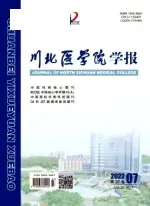噬菌体展示技术*
2011-07-11刘世喜
冯 俊,李 丽,刘 海,刘世喜
(1.四川大学华西医院耳鼻咽喉-头颈外科,四川 成都 610041;2.川北医学院病理教研室;3.川北医学院附属医院耳鼻咽喉-头颈外科,四川 南充 637000)
1 噬菌体展示技术的研究历史
噬菌体展示技术是近年才发展起来并得到广泛应用的新技术,Smith[1]于1985年首次将外源基因插入丝状噬菌体f1的基因Ⅲ,使编码的目的基因的多肽以融合蛋白的形式展示在噬菌体表面,从而创建了噬菌体展示技术,将丝状噬菌体fd基因组通过基因工程的手段进行改造,将EcoRⅠ内切酶的部分基因片段与PⅢ基因融合,获得的重组噬菌体可在体外稳定增生。1988年Pannley et等[2],将已知抗原决定族与PⅢ的N端融合呈现在表面,可特异性地被抗体选择出来,并提出通过构建随机肽库可以了解抗体识别的抗原决定簇表位的设想。
2 噬菌体展示技术的基本原理
噬菌体展示技术是一种亲和选择和基因表达产物相结合的技术,以改造的噬菌体为载体,将外源多肽或蛋白与噬菌体的一种衣壳蛋白融合表达,融合蛋白将展示在病毒颗粒的表面,而编码这个融合子的DNA则位于该病毒粒子内,通过检测病毒内部的DNA来测定融合蛋白序列。噬菌体展示技术使大量随机多肽与其DNA编码序列之间建立了直接联系,使得各种靶分子的多肽配体通过一种被称为淘选的体外选择程序得以快速鉴定(如图1)。噬菌体结构蛋白PIlI和PⅧ均可作为载体来展示外源多肽或蛋白质。在成熟蛋白质编码区与信号肽之间有单一的克隆位点用于插入,插入的外源多肽或蛋白质以融合的形式表达在病毒粒子的表面,外源多肽或蛋白的插入结合点在N端,与PⅧ基因融合时,拷贝数高,可达2700个;与PllI基因融合时拷贝数低(约5个拷贝数),利于选择高亲和力的配体分子,因而可对插入较大的片段进行筛选。

3 噬菌体展示系统
3.1 单链丝状噬菌体展示系统
丝状噬菌体常见的如M13、f1、fd等是单链DNA病毒,PⅢ是病毒的次要外壳蛋白;PⅧ是丝状噬菌体的主要外壳蛋白;PⅢ位于病毒颗粒的尾端,是噬菌体感染所必须的[3]。PⅧ位于噬菌体外侧,N端伸出噬菌体外,C端与DNA结合,每个病毒颗粒大约有2700个拷贝。此外,尚有丝状噬菌体PVI展示系统的研究报道[4]PVI蛋白可以作为外源蛋白的融合位点,可以用于研究外源蛋白C端结构区域功能,从而用于cDNA展示文库的构建。
3.2 λ噬菌体展示系统
λ噬菌体的尾部管状部分由PV蛋白构成,由32个盘状结构组成尾部管状结构,由6个PV亚基组成一个盘状结构。PV有两个折叠区域,外源序列替换或插入在c端的折叠结构域。λ噬菌体的D蛋白参与野生型噬菌体头部的装配。
3.3 T4噬菌体展示系统
T4噬菌体展示系统是将噬菌体衣壳表面上的SOC外壳蛋白和HOC融合而直接展示于T4噬菌体的表面,因此它表达的蛋白不需要复杂的蛋白纯化,避免了因纯化而引起的蛋白质变性和丢失,故而T4可展示各种大小的多肽或蛋白质。
4 噬菌体展示技术的应用
4.1 噬菌体随机多肽文库
肽库由感染性噬菌体构成,通过淘选可以富集与靶分子结合的噬菌体。随机肽库的筛选分子包括抗体、细胞表面受体类、小分子、完整细胞、细胞分子类[5,6]等,这些分子谓之受体,筛选出的结合该类受体的目的分子称为配体。目前应用较多的是进行抗体的表位分析,而筛选出的配体常常展示了抗原抗体的结合部位。噬菌体展示肽库发展较快,已由最初的6肽、7肽、发展到9肽、15肽,直到38肽、40肽[7,8]。Blond-Elguindi[9]等采用甲胎蛋白(AFP)洗脱的策略筛选出Bip结合短肽的共有序列,阐明Bip识别和蛋白质折叠的机制。Doorbar[10]等采用竞争洗脱的方法筛选出细胞表面受体特异性结合的短肽;张旭[11]等成功地筛选出肝癌特异性的短肽FQPLPAT;Pasqualini[12]等成功地筛选出肠和胃组织特异性的短肽,以及我们最近利用噬菌体随机展示技术筛选出喉癌特异性结合的短肽-WPSTYMNPFNRS(未发表)等。
4.2 抗体工程与噬菌体展示技术
利用噬菌体展示技术可筛选到亲和力和特异性都较高的抗体,噬菌体展示技术的发展使抗体工程进入又一次革命。McCaffery[13]等证实,完整的抗体可变区可展示于噬菌体的表面,通过筛选获得了与已知抗原特异性结合的抗体片段。Hogrefe[14]等筛选到特异的Fab片段。噬菌体抗体库构建和单克隆抗体的筛选是噬菌体展示技术的成功应用。
4.3 蛋白质工程与噬菌体展示技术
4.3.1 新受体和配体的发现:利用噬菌体展示技术,最近发现了一些新的受体及其配体[15-17]。Heiskanen等用完整的Puumala汉坦病毒进行淘选,其分离的多肽能与汉坦病毒结合,并使该病毒不能感染或结合细胞。
4.3.2 蛋白与蛋白间相互作用的研究:噬菌体展示技术和蛋白水解作用相结合可筛选稳定折叠的蛋白,从而能更好的研究蛋白与蛋白间相互作用[18-21]。由于这种方法不依赖蛋白的特异性,理论上讲它适用于任何蛋白,故用此种方法可生产新的高适温性蛋白,可使多肽片段形成新的折叠结构域,部分折叠区形成完全折叠。
4.3.3 蛋白质的定向设计和空间结构:可用来筛选细胞因子、酶抑制剂、细胞因子拮抗剂、转录因子的DNA结合位点、新型酶和生物学活性的蛋白质等领域。
4.3.4 抗原表位分析:抗原表位分析在研究抗原一抗体反应机制方面具有重要意义,通过噬菌体展示技术筛选出任何抗原的特定抗体[22,23]。此技术还可用于设计多肽疫苗、研制诊断试剂和筛选药物等领域。Motti[24]用15肽库筛选2株抗人乙肝表面抗原,而获得的多肽不仅可以与抗人乙肝表面抗原单抗结合,而且可被乙肝患者的血清抗体识别。
4.3.5 噬菌体展示技术与药物工程:由于对蛋白质结构与功能关系不够了解,以往只能通过大规模的定点突变和单个目的蛋白的克隆表达纯化与筛选来修饰现有蛋白,此方法费时费力。而使用噬菌体展示技术就可以简便快速地获得与靶分子具有强亲和力和特异性的小肽或新型蛋白作为候选药物开发。目前该技术已广泛用于癌症的靶向治疗,组织器官移植、艾滋病、心血管病、神经性疾病等领域药物的研究和开发,并已筛选出大量的受体拮抗物、酶抑制剂等[25]。
5 问题与展望
综上所述,噬菌体展示肽库技术以其独特的优势,在生物医学的许多领域应用非常广泛[26-32],为后来的研究者提供了崭新的研究方向。其中,定位抗原表位是最具应用前景的;运用噬菌体展示技术可筛选出与肿瘤细胞特异结合的多肽,从而为肿瘤的靶向治疗提供了可能。另外,噬菌体展示肽库技术亦还有很多不足需要改进方面:如筛选的特异性不高、如何更有效的避免筛选背景的影响、提高库容量;改善密码子的表达偏性等。但相信不久的将来,随着该技术的进一步发展和完善,人们完全可以筛选和鉴别出更多、更广的靶分子,并创造出具有实际应用价值的模拟肽;使噬菌体展示技术在更多领域中应用,产生更深远的影响。
[1]Smith GP.Filamentous fusion phage:novel expression vectors that display cloned antigens on the virin surface[J].Science,1985,(228):1315-1317
[2]Parmley SF,Smith GP.Antibody selectable fnamentous fd phagevectors affitty purification of target genes[J].Gene,1988,(73):305-318
[3]Zaman G J,Kaan A M,Schoenmakers G J,et al.Gene V protein mediated trandation regulatlon of the synthesis of geneⅡprotein of the filamentous bacterophage MI3:A dispensable function of the filamentous-phage genome[J].Bacteriol,1992,174(2):595 - 600
[4]Jespers L,StMessens J,H De Keyser A,et al.Surface expression and figand based selecfion of cDNA fused to filamentous phage gene VI[J].Biotechnology,1995,13(4):l378 -1382
[5]Pereira S,Maruyama H,Siegel D,et al.A model system for detection and isolation of a tumor cell surface antigen using antibody phage display[J].J Immunol Methods,1997,(203):11 -24
[6]Figini M,Obici L,Mezzanzanica D,et al.Panning phage antibody libraries on cells:isolation of human Fab fragments against ovarian carcinoma using guided selection[J].Cancer Res,1998,(58):991-996
[7]Kay BK,Adey NB,He YS,et al.AM13 phage library displaying random 38-amino-acid peptides as a source of novel sequences with affinity to selected targets[J].Gene,1993,12(1):59 -65
[8]Ravera MW,Carmo J.Identification of an allosteric binding site on the transcription factor p53 using a phage displayed peptide library[J].Acta Bicochem Pol,1997,44(4):839 -847
[9]Blond Elguindi S,Cwirla SE,Dower WJ,et al.Affity panning of a library of peptides displayed on bacteriophages reveals the binding specificity of BiP[J].Fi,1993,(75):717 -728
[10]Doorbar J,Winter G.Isolation of a peptide antagonist to the thrombin receptor using phage display[J].Mol Biol,1994,244(4):361-369
[11]张 旭,彭 健,王顺伟,等.噬菌体随机肽库对肝癌细胞特异性结合短肽的筛选及鉴定[J].第四军医大学学报,2008,29(17):20-23
[12]Pasqualini R,Ruoslahti E.Organ targeting in vivo using phage display peptide libraries[J].Nature,1996,(380):364 -366
[13]Mccafferty J,Griffiths AD,Winter G,et al.Phage antibodies:filamentous phage displaying antibody variable domains[J].Nature,1990,348(6301):552 -554
[14]Hogrefe HH,Mullinax RL,Lov-oy AE,et al.A bacteriophage lambda vector for the doningan dexpression of immunoglobulinFab on the surfaceofilam entousphage[J].Gene,1993,(128):119 -126
[15]Mazzucchelli L,Burritt JB,Jesaitis AJ,et al.Cell-specific peptide binding by human neutrophils[J].Blood,1999,93(5):1738 -1748
[16]Brown KC.New approaches for cell-specific targeting:Identification of cell-selective peptides from combinatorial libraries[J].Curr Opin Chem Biol,2000,4(1):l6 -2l
[17]Zurita AJ.Arap w_Pasqualini R Mapping tumor vascular diversity by screening phage display libraries[J].J Control Release,2003,91(1-2):183-186
[18]Goodson RJ,Doyle MV,Kaufman SE,et al.High-affinity urokinase receptor antagonists identified with bacteriophage peptide library[J].Proc Natl Acad Sci USA,1994,(91):7129 -7133
[19]Akeson AL,Woods CW,Hsieh LC,et al.AF 12198,a novel low molecular weight antagonist,selectively binds the human type I interleukin(IL)-1 receptor and blocks in vivo responses to IL-1[J].J Biol Chem,1996,(271):30517 -30523
[20]O'Neil KT,Hoess RH,Jackson SA,et al.Identification of novel peptide antagonists for GP II b/IIIa from a conformationally constrained phage peptide library[J].Proteins,1992,14(4):509 -515
[21]Koivunen E,Gay DA,Ruoslahti E.Selection of peptides binding to the a5b1 integrin from phage display library[J].J Biol Chem,1993,(268):20205 -20210
[22]Topping KP,Hough VC,Monson JR,et al.Isolation of human colorectal tumor reactive antibodies using phage display technology[J].Int J Oncol,2000,16(1):187 -195
[23]Suzu UY,Ito S,Otsuka K,et al.Preparetion of functional single chain an tibodies against bioactive Gibberellins by utilizing randomly mutagenized phage-display libraries[J].Biosci Biotechnol Biochem,2005,69(3):6l0 -619
[24]Motti C,Nuzzo M,Meola A,et al.Recognition by human sera and immunogenicity of HBsAg mimotopes selected from an M 13 phage display library[J].Gene,1994,146(2):191 - 198
[25]Lee JY,Cho PY,Kim TY,et al.Hemolytic activity and developmental expression of pore-forming peptide,clonorin[J].Biochem Biophys Res Com mun,2002,296(5):l23 -124
[26]Marks JD,OuwehandWH,Bye JM,et al.Human antibody fragments specific for human blood group antigens from a phage display library[J].Biotechnology(NY),1993,(11):1145 -1149
[27]Portolano S,McLachlan SM,Rapoport B.High affinity,thyroidspecific human auto antibodies displayed on the surface of filamentous phage use genes similar to other auto antibodies[J].J Immunol,1993,(151):2839 -2851
[28]De KruifJ,Terstappen L,Boel E,et al.Rapid selection of cell subpopulation-specific humanmonoclonal antibodies from a synthetic phage antibody library[J].Proc Natl Acad Sci USA,1995,(92):3938-3942
[29]Van Ewijk W,De Kruif J,Germeraad WT,et al.Subtractive isolation ofphage-displayed single-chain antibodies to thymic stromal cells by using intact thymic fragments[J].Proc Natl Acad Sci USA,1997,(94):3903 -3908
[30]Cai X,Garen A.Anti-melanoma antibodies from melanoma patients immunized with genetically modified auto logous tumor cells:selection of specific antibodies from single-chain Fv fusion phage libraries[J].Proc Natl Acad Sci USA,1995,(92):6537 -6541
[31]Cai X,Garen A.A melanoma-specific VH antibody cloned from a fusion phage library of a vaccinated melanoma patient[J].Proc Natl Acad Sci USA,1996,(93):6280-6285
[32]Cai X,Garen A.Comparison of fusion phage libraries displaying VH or single chain Fv antibody fragments derived from the antibody repertoire of a vaccinated melanoma patient as a source of melanoma-specific targeting molecules[J].Proc Natl Acad Sci USA,1997,(94):9261 -9266
